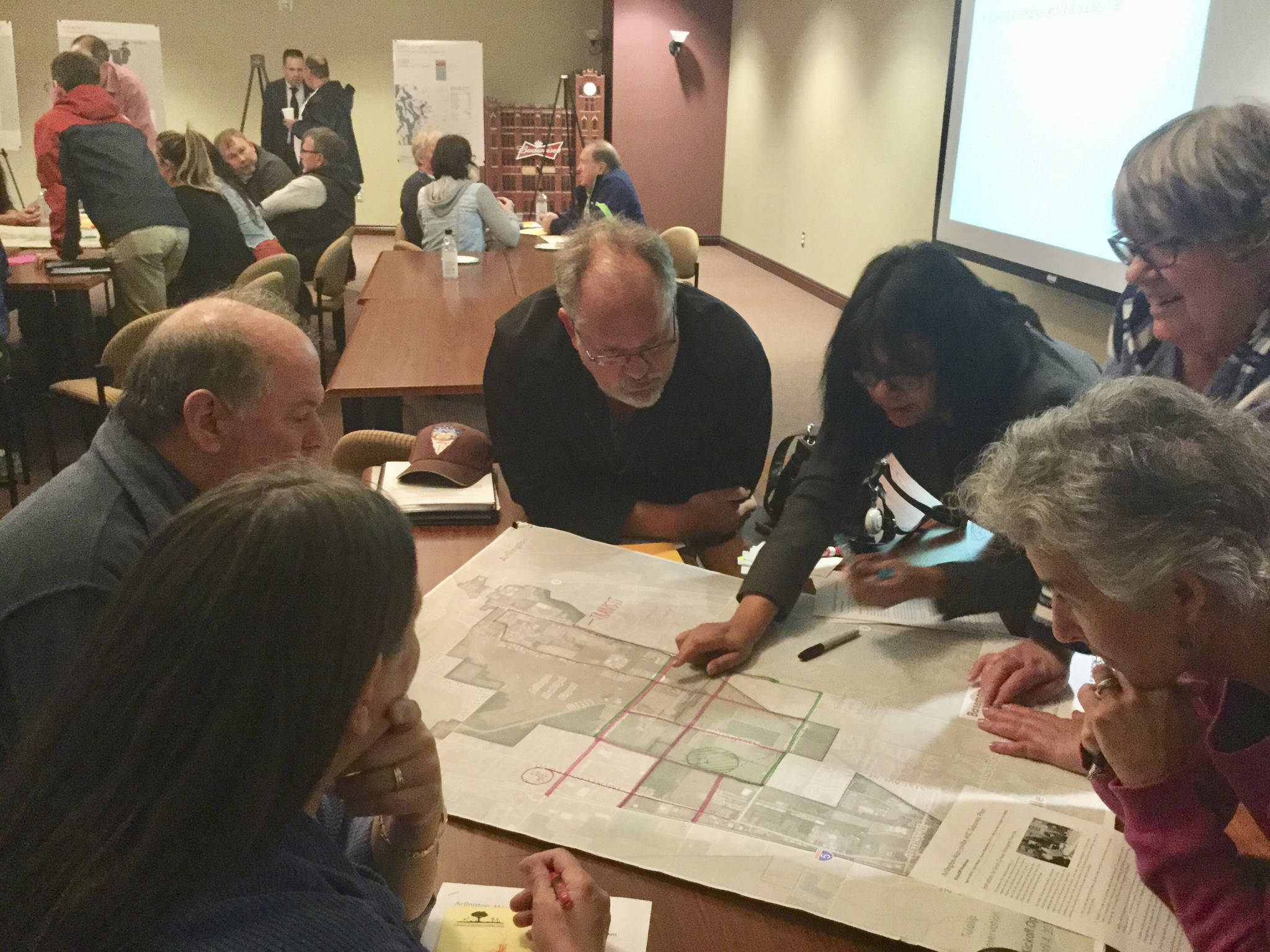ARLINGTON – Nothing brings out the inner urban planner in residents more than a tabletop workshop with maps, markers, sticky dots and a roomful of ideas.
The public on Wednesday during a mapping exercise got its first chance to draw out the features and improvements they would support for the proposed Arlington-Marysville Manufacturing Industrial Center, and how those can best complement existing residential and commercial activity in the Arlington Airport and Smokey Point areas.
The cities of Arlington and Marysville are jointly creating a subarea plan for the MIC that could become a booming employment center with the potential to create 25,000 family wage jobs by 2040.
The planning is part of the cities’ application for MIC designation through the Puget Sound Regional Council, which, among other advantages, moves the area higher up the priority list for transportation grant funding.
“Subarea planning is an opportunity for everyone involved to come together and coordinate our vision for the area for the next twenty years,” Radhika Nair, subarea project manager with Berk Consulting, said during a kickoff workshop at Crown Distributing that drew about 80 people, including elected officials and staff from both cities.
Total land area within the MIC boundaries includes 4,019 acres, of which 57 percent is in Arlington and 43 percent in Marysville, which includes the Arlington Municipal Airport and land south of 172nd Street NE in the Smokey Point area. About 1,762 acres – 44 percent – consists of land ready to develop or redevelop. The state awarded both cities grants for the planning.
“The cities want the public’s insights to better understand the needs and concerns of manufacturing and industrial businesses and issues that the subarea plan can address,” Nair said. “They want the knowledge and ideas from people who know the area well.”
Participants came ready with a wide range of ideas and concerns that covered transportation, economic development, the nature of industry to attract, the environment and other aspects.
Several attendees focused on 172nd Street NE, insisting that sidewalks, transit service and bus stops are a must in the corridor. Arlington and the state have widening plans and other traffic enhancement planned in the future to better alleviate traffic congestion, but only to 67th Avenue NE.
“Some people focused on east-west circulation mostly, and having 172nd go all the way over to Highway 9,” said John Owen, a partners with Makers, a Seattle-based architecture, planning and urban design sub-consultant on the project. Also, 152nd and 156, which will eventually become a full interchange at I-5, needs to extend east as well.
Kristin Kinnamon said more transportation connections need to be created that would provide for transit and shuttle service, and trails and sidewalks for biking and walking that could link with the Centennial Trail to the east.
Arlington City Councilman Mike Hopson raised the idea of using the rail spur that runs through the MIC area to have commuter service connecting with the Everett Train Station, since light rail isn’t going to come this far north.
In terms of light industry that participants mentioned, expanding aerospace manufacturing, cannabis production and adding food processing and more general manufacturing were preferred to warehouse and distribution facilities that use a lot of land, but do not bring as many jobs for the amount of space taken.
Matt Fontaine, water resources engineer with sub-consultant Herrera, spoke for his mapping group that debated the environmental challenges.
“The main thing that came up was how these streams get integrated into the environment – value of salmon verses value of developable land,” Fontaine said. “It’s a tough call.”
Owen shared that focus should be on design quality and integrating the streams and buffers so you don’t need to reconfigure hydrological aspects as much so the streams remain viable and healthy.
Marysville City Councilman Mark James was among many who said the MIC needs to blend in well with existing neighborhoods and businesses, with landscaping, buffers and form that are consistent with the aesthetics of the cities.
City officials said there have been some commercial interest generated by MIC talks, but a local businessman said the permit process needs to be made easier and feasibility studies done upfront in advance of investors making the jump.
Owen said many participants said that infrastructure like roads and utilities needs to go in first, but the question would remain how to fund it.
Nair said more opportunities will be available to gather input from the public. Berk hopes to have the subarea plan completed by the end of the year, concurrent with the cities’ MIC application for designation to the PSRC.
MIC Online Survey
The cities of Arlington and Marysville invite the public to take a brief online survey to share ideas for what should be addressed in the MIC subarea plan



